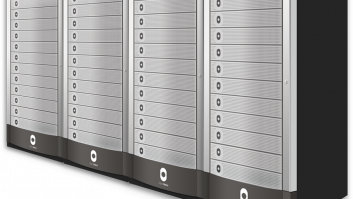With media organisations having to manage more content, and larger file sizes than ever before, traditional disk and tape storage solutions can no longer meet evolving demands. What’s needed is a more scalable, intelligent and cost-effective storage foundation – and one that doesn’t just hold a media archive but provides anytime, anywhere access and a way to extract more value from this asset. As with many digital technologies these days, the ideal solution is to leverage the power of Cloud-derived technology while keeping the archive safely under the user’s control.
A more challenging media environment
One of the key drivers of growing content volumes is the shift to higher-quality formats and resolutions. 4K is becoming more and more ubiquitous, and pixel counts are only going to get bigger with 8K and even 16K looming on the horizon.
Frame rates are also increasing. No longer is everything captured at 24 frames per second (fps). There are now productions at 48 fps and 60 fps, and they are likely to go as high as 300 fps. To put this growth in file size into context, one hour of standard definition (SD) film content equates to 112 gigabytes (GB) of storage space at uncompressed data rates; high definition (HD) adds up to 537 GB, and Ultra HD to 6,880 GB.
In addition, with so many distribution platforms available to reach new audiences, more versions of the same piece of content must be produced and managed to meet the unique delivery specifications of each service.
On top of this, artificial intelligence and machine learning applications provide opportunities to search, identify, tag and retrieve content more quickly and comprehensively than is manually possible. As a result, media organisations can extract more value from their content archives.
Traditional storage solutions fall short
Given this evolving media landscape, storage has never been more vital to the success of any organisation that works with content. However, the traditional SAN and NAS disk systems and tape storage that have been relied on for so long simply can’t keep pace with the demands of today’s media workloads. This is especially the case in the current ‘do more for less’ media environment where margins are continuously squeezed.
The cost of traditional disk-based systems becomes increasingly prohibitive at large scale, and tape storage entails management and latency issues, including the time it takes to retrieve content stored offsite.
What’s needed is a way to seamlessly and cost-effectively scale to hundreds of petabytes without interruption or downtime.
Looking to the skies
Over the last several years, organisations across a range of industries have turned to the public Cloud to meet their storage needs. In a public Cloud model storage is delivered as a third-party service, freeing up internal time and resources and providing much greater scalability and flexibility than traditional storage. In addition, the low cost of storing data in the public Cloud makes it extremely attractive at first glance.
However, the costs of storing and accessing data in the public Cloud can quickly add up, and the time required to retrieve it can be significant, particularly in the case of large files. In addition, there are control and security issues that media organisations should consider before putting their valuable intellectual property in the hands of someone else.
In contrast, an onsite, private Cloud is specifically operated by an organisation for its own use, avoiding the access, control and security issues of the public Cloud. At the same time, however, private Clouds require internal infrastructure and management expertise.
Object storage – the best of both worlds
Developments in data storage technology, such as Cloudian’s new HyperStore Xtreme storage offering, provide a much-needed solution to the public versus private Cloud conundrum for content owners and distributors.
With this type of solution, media organisations can experience the equivalent scale and flexibility benefits of the largest public Clouds such as Amazon AWS, Google Cloud and Microsoft Azure, but from within the walls of their own facilities. In addition, the underlying technology enables users to store, find and protect media seamlessly across sites, both onsite and in public Clouds, within a single, unified platform.
Organisations can scale their storage capacity up to an exabyte of data without interruption. And because of the unified management feature, content can be easily accessed whenever and wherever it is needed.
In addition, these new private Cloud systems meet criteria critical to media organisations. These include automated data protection, replication across facilities for collaboration and disaster recovery, and rich metadata tagging that facilitates Google-like search and AI/analytics applications. These benefits – coupled with seamless integration with one or more public Clouds and significant cost savings compared to public Cloud services – make these private Cloud offerings extremely attractive.
The secret sauce
So how does it work? The key is the use of an object storage architecture as opposed to more traditional approaches such as file or block storage. Rather than organising stored content into a hierarchy with directories and sub-directories, object storage uses a flat address system in which data is stored as objects along with metadata tags and a unique identifier.
Object storage is ideal for holding huge volumes of unstructured data such as video and audio and provides limitless scalability – as more capacity is needed, additional storage nodes can be added without interruption, and that capacity immediately becomes part of the available storage pool. In addition, the flat address system makes it easier to locate and retrieve content at different sites.
Because the metadata in object storage is customisable, it allows users to go beyond the limited and basic information that can be tagged in traditional file systems to include such content details as faces, other images and logos. As a result, object storage can facilitate and greatly accelerate AI/ML processes, enabling media organisations to repurpose archive content and capitalise on new revenue opportunities.
Archived media is most valuable when it can be easily and quickly accessed for commercial or creative gain. However, this requires a highly scalable and cost-effective storage foundation that traditional solutions can’t provide and the control and security that public Clouds can’t guarantee. That’s why content owners and distributors would be wise to look at object storage-based private Clouds to meet the evolving demands they face in today’s media landscape.







